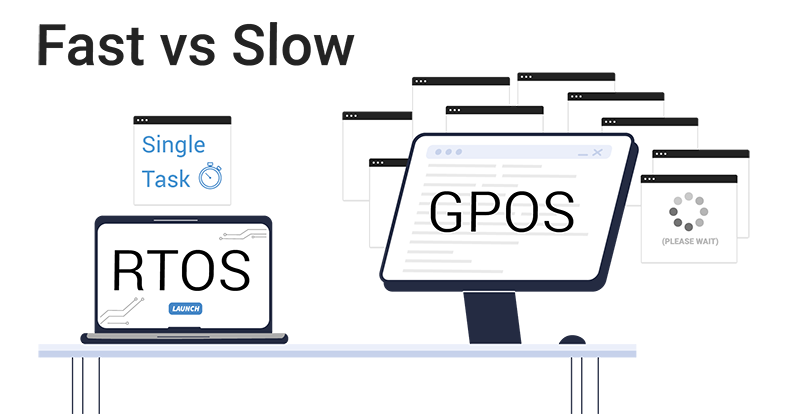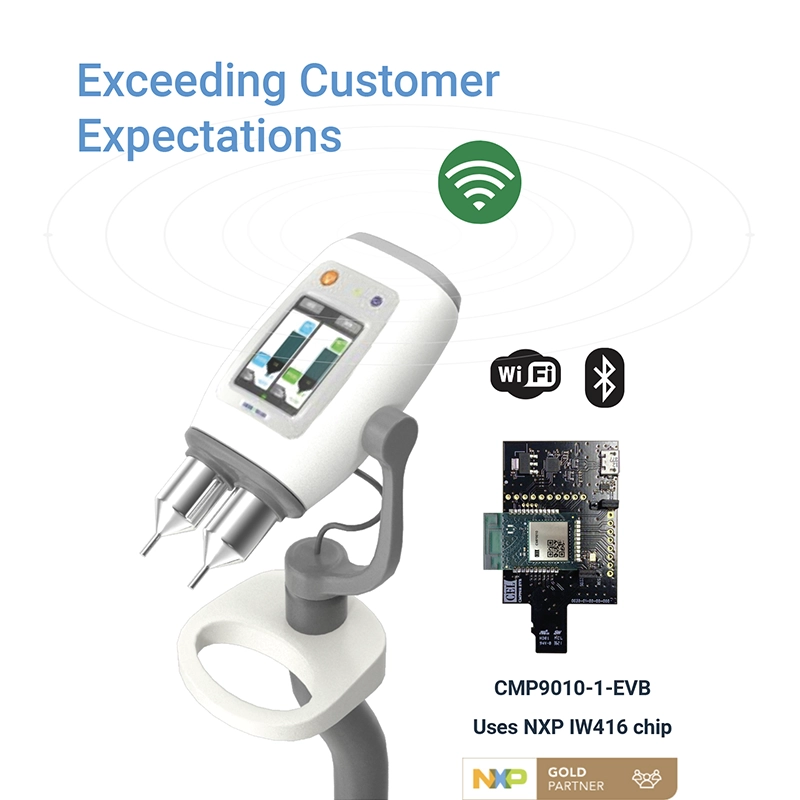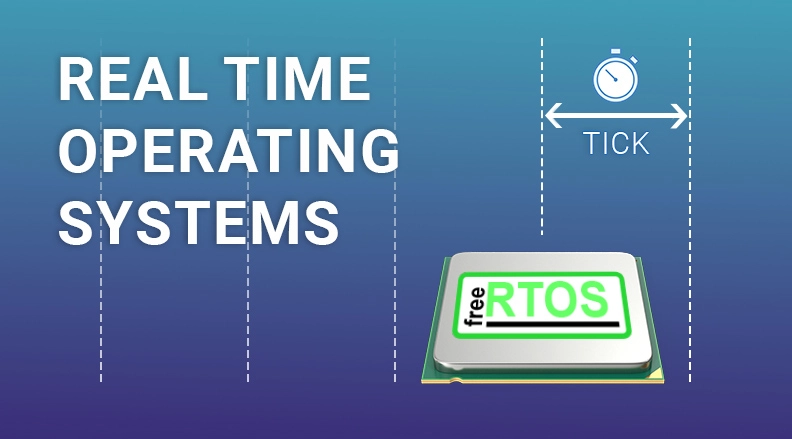What is RTOS?
Real Time Operating System (RTOS) is software designed to manage hardware resources and execute program code fast. Unlike standard operating systems, RTOS prioritizes the timely execution of tasks to ensure that real-time applications perform as expected. This is particularly crucial in environments where the time it takes for the system to respond to external events is critical. Let’s learn more about this type of OS.
GPOS vs. RTOS
When it comes to response time for medical devices, every second counts. This is where understanding the distinction between a General-Purpose Operating System (GPOS) and a Real-Time Operating System (RTOS) is important.
General-Purpose Operating Systems (GPOS) like those operating on smartphones and laptops, are designed to handle a wide range of applications simultaneously, prioritizing multitasking and user interaction. They schedule tasks based on priority and availability, aiming for a balanced performance across all processes. They usually run with multiple CPUs to ensure that users can browse the internet, play music, and edit documents concurrently without noticeable lag.
In contrast, Real-Time Operating Systems (RTOS) is streamlined for precision and reliability, executing tasks based on real-time requirements rather than a fixed schedule. Unlike GPOS, which thrive on multitasking and user-centric operations, RTOS typically dedicates itself to a single program at a time, often running on single-core processors. This focus allows RTOS to provide deterministic performance crucial in environments like medical device operation, where timing is not just a convenience but a necessity.
Furthermore, the speed at which these systems operate is fundamentally different. GPOS prioritizes fairness and user experience, managing resources to provide a balanced performance across all running applications. This approach can lead to variable response times since the system juggles numerous tasks. On the other hand, an RTOS prioritizes tasks based on their urgency and importance, ensuring that critical operations, such as monitoring a patient’s vital signs, are not delayed by less critical processes. This can mean the difference between a timely medical intervention and a missed critical alert.

Key Features of RTOS:
Determinism: RTOS guarantees task execution within a specific time frame, ensuring predictable responses to events, which is vital for critical applications.
Real-Time Scheduling: Tasks are prioritized based on urgency, ensuring high-priority tasks are executed first, which is crucial for maintaining system integrity and performance. RTOS allows developers to explicitly define task priorities, ensuring that the most critical functions have the highest priority and are attended to promptly.
Minimal Latency: RTOS minimizes delay in task switching and interrupt handling, crucial for time-sensitive applications where immediate response is required.
Reliability and Fault Tolerance: Designed for continuous operation, RTOS includes mechanisms for error checking and recovery to handle system failures effectively.
Multi-threading and Synchronization: Supports concurrent execution of multiple threads while providing synchronization mechanisms to prevent data conflicts and ensure system stability.
These features make RTOS indispensable for systems where timing, reliability, and efficiency are critical, such as in aerospace, automotive controls, and of course, medical devices.
Real-world examples of medical devices that utilize RTOS:
Pacemakers and Defibrillators: These life-saving devices must respond immediately to heart irregularities. RTOS allows them to monitor the heart’s rhythm accurately and provide electrical stimulation at the exact moment it’s needed.
Ventilators: These devices, crucial for patients who cannot breathe on their own, use RTOS to regulate the flow and pressure of air to the patient’s lungs, ensuring the patient receives the right amount of oxygen based on their needs.
Infusion Pumps: These are used to deliver fluids, such as nutrients and medications, into a patient’s body in controlled amounts. RTOS ensures the delivery is precise and consistent, critical for medications that require exact dosages.
Medical Imaging Systems: Devices like MRI machines, CT scanners, and ultrasound devices rely on RTOS for the real-time processing and analysis of complex imaging data, ensuring that healthcare professionals can make accurate diagnoses quickly.

Check out CEL’s Case Study, Involving a Medical Diagnostic Imaging System incorporating CEL’s CMP9010 module with a FreeRTOS. The customer was thrilled with the performance of the system’s connectivity and response from a distance in a noisy environment. Not to mention the fast speed in which the team was able to provide support and move the projects to compilation. Find out more here.
California Eastern Laboratories’ modules can provide the connectivity backbone your projects need. Their compatibility with major RTOS platforms such as Linux, FreeRTOS, ARM Mbed, and Android ensures that you can maintain real-time performance while leveraging the benefits of established operating systems.
For more information on how these connectivity modules can enhance your IoT solutions, and to ensure your projects are powered by reliable and high-performance technology, visit California Eastern Laboratories’ Connectivity Modules.
Conclusion
Understanding the nuances between RTOS and GPOS highlights the importance of choosing the right operating system for the right application – especially when lives are on the line. With the integration of CEL’s connectivity modules, medical devices can achieve not only the real-time response necessary for patient safety but also the interconnectedness required in today’s healthcare landscape.




